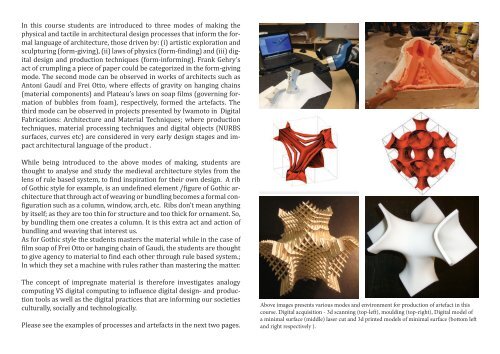Impregnate material - KTH
Impregnate material - KTH
Impregnate material - KTH
Create successful ePaper yourself
Turn your PDF publications into a flip-book with our unique Google optimized e-Paper software.
In this course students are introduced to three modes of making the<br />
physical and tactile in architectural design processes that inform the formal<br />
language of architecture, those driven by: (i) artistic exploration and<br />
sculpturing (form-giving), (ii) laws of physics (form-finding) and (iii) digital<br />
design and production techniques (form-informing). Frank Gehry’s<br />
act of crumpling a piece of paper could be categorized in the form-giving<br />
mode. The second mode can be observed in works of architects such as<br />
Antoni Gaudí and Frei Otto, where effects of gravity on hanging chains<br />
(<strong>material</strong> components) and Plateau’s laws on soap films (governing formation<br />
of bubbles from foam), respectively, formed the artefacts. The<br />
third mode can be observed in projects presented by Iwamoto in Digital<br />
Fabrications: Architecture and Material Techniques; where production<br />
techniques, <strong>material</strong> processing techniques and digital objects (NURBS<br />
surfaces, curves etc) are considered in very early design stages and impact<br />
architectural language of the product .<br />
While being introduced to the above modes of making, students are<br />
thought to analyse and study the medieval architecture styles from the<br />
lens of rule based system, to find inspiration for their own design. A rib<br />
of Gothic style for example, is an undefined element /figure of Gothic architecture<br />
that through act of weaving or bundling becomes a formal configuration<br />
such as a column, window, arch, etc. Ribs don’t mean anything<br />
by itself; as they are too thin for structure and too thick for ornament. So,<br />
by bundling them one creates a column. It is this extra act and action of<br />
bundling and weaving that interest us.<br />
As for Gothic style the students masters the <strong>material</strong> while in the case of<br />
film soap of Frei Otto or hanging chain of Gaudi, the students are thought<br />
to give agency to <strong>material</strong> to find each other through rule based system.;<br />
In which they set a machine with rules rather than mastering the matter.<br />
The concept of impregnate <strong>material</strong> is therefore investigates analogy<br />
computing VS digital computing to influence digital design- and production<br />
tools as well as the digital practices that are informing our societies<br />
culturally, socially and technologically.<br />
Please see the examples of processes and artefacts in the next two pages.<br />
Above images presents various modes and environment for production of artefact in this<br />
course. Digital acquisition - 3d scanning (top-left), moulding (top-right), Digital model of<br />
a minimal surface (middle) laser cut and 3d printed models of minimal surface (bottom left<br />
and right respectively ).
















